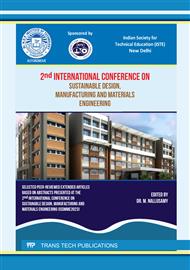[1]
https://tnsdma.tn.gov.in/app/webroot/img/document/map/2021/tn_seismic_damage_zones
Google Scholar
[2]
https://www.steel-silo.com/cement-storage-silo-in-india.html
Google Scholar
[3]
Osama Khalfalla Alshambati, Majdi Elgaili Mukhtar Ahmed, "Analysis and Design of RCC Silo for Storage of 2000 ton using E-Tabs Software", International Journal of Engineering Research & Technology (IJERT), Vol. 12 Issue 03, March-2023.
Google Scholar
[4]
T. Sharaf1, M. Hassan, 0. M. Ramadan, "Seismic Analysis of RC Flat Bottom Circular Clinker Silos", Electronic Journal of Structural Engineering 23 (1) (2023).
DOI: 10.56748/ejse.233371
Google Scholar
[5]
Zhijun Xu & Pengfei Liang, "Modifed lateral pressure formula of shallow and circular silo considering the elasticities of silo wall and storage materials", Scientific Reports, Article number: 7069 (2022).
DOI: 10.1038/s41598-022-11305-6
Google Scholar
[6]
Mohammad Khalil, Sergio Ruggieri and Giuseppina Uva, "Assessment of Structural Behavior, Vulnerability, and Risk of Industrial Silos: State-of-the-Art and Recent Research Trends", Applied Sciences - 12(6), Article number:3006 (2022).
DOI: 10.3390/app12063006
Google Scholar
[7]
Stefano Silvestri, Sulyman Mansour, Matteo Marra, Johann Distl, Marco Furinghetti, Igor Lanese, Enrique Hernández-Montes, Caterina Neri, Michele Palermo, Alberto Pavese, Elisa Rizzo Parisi, Adam Jan Sadowski, Francesco Selva, Tomoyo Taniguchi, Laura Vadrucci, Felix Weber, "Shaking table tests of a full-scale flat-bottom manufactured steel silo filled with wheat: Main results on the fixed-base configuration", Earthquake Engineering & Structural Dynamics 51:169–190 (2022).
DOI: 10.1002/eqe.3561
Google Scholar
[8]
Than Zaw Oo, Nang Yi Phoo Thet, Aung Myo San Hlaing, "Design and Pressure Analysis of Steel Silo (8000) Tons", International Journal of Trend in Scientific Research and Development (IJTSRD) Volume 3 Issue 5, August 2019.
Google Scholar
[9]
Qing Shuai Cao, Yang Zhao, Ru Zhang, "Wind-induced buckling of large circular steel silos with various slenderness", Thin-Walled Structures, Volume 130, September 2018, Pages 101-113.
DOI: 10.1016/j.tws.2018.05.005
Google Scholar
[10]
Amir R. Shokrzadeh, Mohammad R. Sohrabi, "Buckling of ground-based steel tanks subjected to wind and vacuum pressures considering uniform internal and external corrosion", Thin-Walled Structures, Volume 108, November 2016, Pages 333-350.
DOI: 10.1016/j.tws.2016.09.007
Google Scholar
[11]
IS 2062 (2011): Hot Rolled Medium and High Tensile Structural Steel [MTD 4: Wrought Steel Products], Bureau of Indian Standards, New Delhi.
Google Scholar
[12]
IS 9178-3 (1980): Criteria for Design of Steel Bins for Storage of Bulk Materials, Part 3: Bins Designed for Mass Flow and Funnel Flow, Bureau of Indian Standards, New Delhi.
Google Scholar
[13]
IS 9178-1 (1979): Criteria for Design of Steel Bins for Storage of Bulk Materials, Part 1: General Requirements and Assessment of Loads, Bureau of Indian Standards, New Delhi.
Google Scholar
[14]
IS 9178-2 (1979): Criteria for Design of Steel Bins for Storage of Bulk Materials, Part 2: Design Criteria, Bureau of Indian Standards, New Delhi.
Google Scholar
[15]
Occupational Safety and Health Administration; OSHA 3124-12R 2003 – Stairways and Ladders
Google Scholar
[16]
IS 8172 (1976): Vertical Steel ladders, Bureau of Indian Standards, New Delhi.
Google Scholar
[17]
SP 6-1 (1964): ISI Handbook for Structural Engineers -Part 1 Structural Steel Sections, Bureau of Indian Standards, New Delhi.
Google Scholar
[18]
IS 800 (2007): General Construction in Steel - Code of Practice, Bureau of Indian Standards, New Delhi.
Google Scholar
[19]
IS 2911-1-1 (2010): Design and Construction of Pile Foundations — Code of Practice, Part 1:Concrete Piles, Section 1: Driven Cast In-situ Concrete Piles
Google Scholar
[20]
IS 456 (2000): Plain and Reinforced Concrete - Code of Practice, Bureau of Indian Standards, New Delhi.
Google Scholar
[21]
Dr. T. Revathee, "Foundation Engineering", R-2017, Magnus Publications.
Google Scholar
[22]
https://brecon.de/en/know-how-center/loosening-and-breaking-up/
Google Scholar
[23]
https://www.nagmanflow.com/wp-content/uploads/2019/03/26G-Radar-LM.pdf
Google Scholar
[24]
https://www.pinch-valves.com/products/aerator-pads/
Google Scholar
[25]
IS 875 (Part 3) (1987): Code of Practice for Design Loads (Other Than Earthquake) For Buildings and Structures. Part 3: Wind Loads (Second Revision)
Google Scholar



